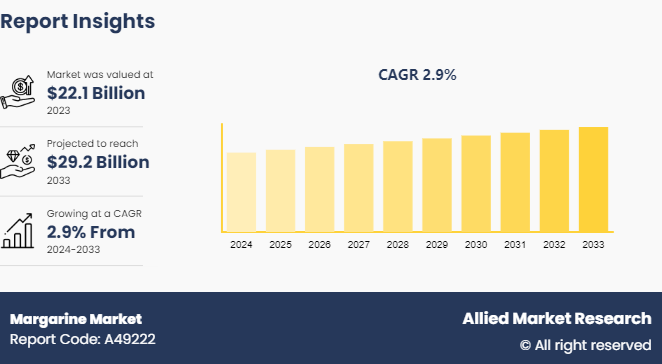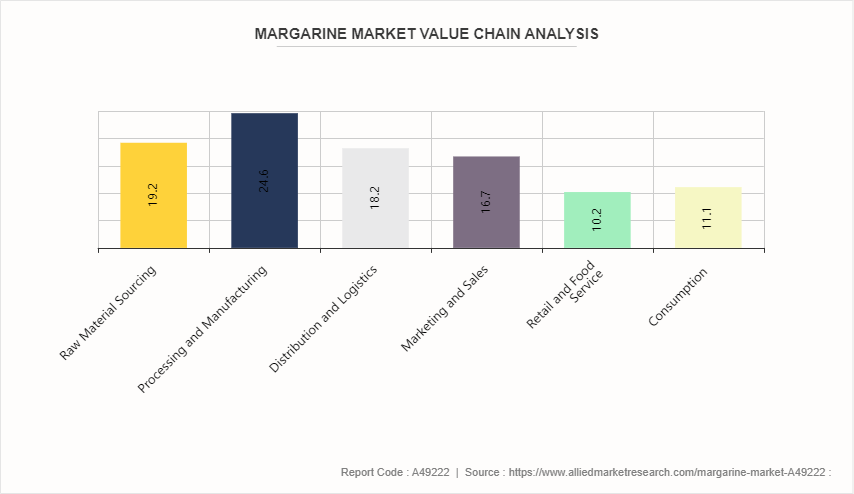Margarine Market Research, 2033
The global margarine market was valued at $22.1 billion in 2023, and is projected to reach $29.2 Billion by 2033, growing at a CAGR of 2.9% from 2024 to 2033.

Market Introduction and Definition
Margarine is a spreadable, butter-like product commonly used as a substitute for butter in cooking, baking, and as a table spread. It is typically made from vegetable oils, such as soybean, palm, or canola oil, which are hydrogenated to solidify the product. Margarine is created through a process called hydrogenation, where unsaturated fats in the oils are converted into saturated fats, resulting in a semi-solid consistency at room temperature. Margarine is often fortified with vitamins, such as vitamins A and D, to mimic the nutritional profile of butter. It is available in various forms, including sticks, tubs, and spreads, with options ranging from regular to reduced-fat or non-hydrogenated varieties. Margarine is valued for its versatility, affordability, and longer shelf life compared to butter.
Key Takeaways
The margarine market study covers 20 countries. The research includes a segment analysis of each country in terms of value ($Billion) for the projected period 2024-2035.
More than 1, 500 product literatures, industry releases, annual reports, and other such documents of major energy storage system industry participants along with authentic industry journals, trade associations' releases, and government websites have been reviewed for generating high-value industry insights.
The study integrated high-quality data, professional opinions and analysis, and critical independent perspectives. The research approach is intended to provide a balanced view of global markets and to assist stakeholders in making educated decisions in order to achieve their most ambitious growth objectives.
Key Market Dynamics
The rise in demand for plant-based and healthier alternatives has significantly boosted the market demand for the global margarine industry owing to shifting consumer preferences toward healthier dietary choices. As health consciousness grows, consumers are increasingly seeking alternatives to traditional butter and spreads that are lower in saturated fats and trans fats. Margarine, particularly plant-based varieties, fulfills the demand by offering products with reduced or zero trans fats and cholesterol. Moreover, the versatility of margarine in various culinary applications, including baking, cooking, and spreading, makes it an attractive option for health-conscious consumers seeking to maintain a balanced diet without compromising on taste or texture. In addition, manufacturers are innovating by introducing margarine products enriched with functional ingredients such as omega-3 fatty acids or fortified with vitamins, further enhancing their appeal in the health and wellness market segment during the margarine market forecast.
However, stringent regulations regarding trans fats pose challenges on the global margarine market growth. Many governments worldwide have implemented regulations limiting the permissible levels of trans fats in food products due to their adverse health effects, particularly on cardiovascular health. As margarine historically contained high levels of trans fats, these regulations directly impact the formulation and production of margarine products. As a result, manufacturers are compelled to reformulate their products to reduce or eliminate trans fats, which often requires significant investment in research and development to find suitable alternatives without compromising on taste, texture, or functionality. In addition, the reformulation process may result in increased production costs, which can be passed on to consumers, potentially making margarine less competitive compared to other spreads or substitutes, thus affecting the margarine market size.
Furthermore, the expansion of product portfolios with innovative flavors and textures in the global margarine market presents numerous opportunities for manufacturers to diversify offerings and cater to evolving consumer preferences. By introduction of new and exciting flavors such as herb-infused or spicy varieties and experimenting with textures such as whipped or spreadable margarine, companies can attract a wider consumer base, including millennials and Generation Z. Moreover, specialty margarine products tailored for specific culinary applications, enriched with functional ingredients such as omega-3 fatty acids or plant sterols, offer health benefits and differentiate brands in a competitive market scenario. These innovations are expected to increase margarine market share and address niche market segments to maintain relevance in a rapidly changing food industry.
Value Chain of Global Margarine Market
The global margarine market value chain commences with the procurement of essential raw materials, such as vegetable oils including palm, soybean, rapeseed, sunflower, emulsifiers, preservatives, and other ingredients, from various suppliers. These raw materials undergo processing and manufacturing, where the oils are refined and blended, emulsified with water and other components, and then flavored, colored, and preserved. Margarine products are packaged in various forms, such as tubs or sticks. The packaged margarine is then distributed through intricate logistics networks, involving transportation to distribution centers, storage, and inventory management. From there, it is supplied to wholesalers, retailers, and food service providers. In addition, marketing and sales activities, including branding, promotions, advertising campaigns, and pricing strategies, drive consumer awareness and demand. Furthermore, retailers display and merchandise the margarine products, while food service establishments incorporate them into their offerings. Ultimately, consumers purchase margarine for various culinary purposes, such as baking, cooking, and spreading for consumption.

Market Segmentation
The margarine market analysis is done on the basis of type, end user, distribution channel, and region. On the basis of type, the market is divided into hard, soft, and liquid. As per end user, the market is categorized into household consumers, HoReCa, and industrial. On the basis of distribution channel, the market is segregated into supermarkets/hypermarkets, specialty stores, convenience stores, online retails, and others. Region wise, the market is analyzed across North America, Europe, Asia-Pacific, and LAMEA.
Regional/Country Market Outlook
In April 2023, the U.S. Food and Drug Administration (FDA) authorized the utilization of margarine water as a spreadable fat in food products. The approval by FDA is anticipated to stimulate an increase in the availability of margarine water products within the U.S. market. Moreover, the U.S. Food and Drug Administration's approval of margarine water as a spreadable fat in food items in April 2023 is expected to open a substantial market opportunity in the U.S., one of the world's largest consumer markets. With increase in demand, manufacturers worldwide are expected to expand their production of margarine water products to meet this growing market segment, thereby driving growth in the global margarine market opportunities.
Europe dominates the global margarine market, as it holds the largest market share driven by the high consumption of food processing. Countries such as Germany and France are leading consumer market for margarine in the region. The demand for industrial margarine in Europe is expected to rise, particularly in the baking and food processing industries. Moreover, industrial margarine companies have significantly expanded their product offerings, targeting younger consumers through robust marketing strategies. The 2021 European Commission report highlights the advanced food processing industry in the region, which comprises 294, 000 firms, constitutes 15.2% of all European industry. Initiatives to nearly eliminate trans fatty acids from retail margarine across Western Europe have driven the edible vegetable oils and fats sector to reformulate products, aligning with dietary recommendations and medical advice. The proactive approach has addressed concerns over the increasing global burden of cardiovascular diseases (CVDs) , fostering the expansion of the margarine market in Europe.
Industry Trends:
Numerous health ministries worldwide have started collaborating with agriculture counterparts to eliminate harmful food components, particularly trans fats, fueling the growth of sustainable margarine market trends. In Argentina, governmental efforts to address high heart risk prompted the adoption of schemes supporting sustainable food practices by eliminating industrially produced trans fats. Dutch margarine manufacturers prioritize non-GMO ingredients, recognizing the industry's evolving demands. Globally, governments are advocating for sustainable food production across meat, dairy, and alternative protein sources. According to the World Economic Forum report in January 2023, 30% of the consumers are inclining toward sustainable food products. As a result, the sustainable food trend highlights a broader shift toward healthier, environmentally conscious food choices.
Competitive Landscape
The major players operating in the margarine market include Associated British Foods, Conagra Brands Inc., Fuji Oil Co. Ltd, Bunge Limited, Wilmar International, Upfield BV, Puratos NV, BRF SA, Richardson International Limited, NMGK Group, Vandemoortele.
Other players in margarine market includes EFKO Group, Goodman Fielder, NMGK Group, Melfort, and so on.
Recent Key Strategies and Developments
In February 2023, Unilever, a major player in the food and beverage industry, announced the introduction of a new range of margarine water products to offer a healthier alternative to traditional margarine, featuring lower fat and calorie content.
In April 2022, Vandemoortele launched Gold Cup margarine range and products that contains 100% vegetable oils and fats that offer functionality and convenience to support the sustainable production of palm oil through RSPO certification.
In November 2021, The Wilmar International Company announced the opening of a new facility for processing and packaging margarine and fat products to strengthen its manufacturing capacity globally.
In September 2021, Fuji Oil Group and ITOCHU Group expanded their vegetable oil business sales channels to cater to new customers to increase foothold and strengthen their presence in the North American market.
Key Sources Referred
U.S. Food and Drug Administration (FDA)
Organic Trade Association (OTA)
Euromonitor International
FiBL (Research Institute of Organic Agriculture)
USDA Economic Research Service (ERS)
Food and Agriculture Organization of the United Nations (FAO)
National Restaurant Association (NRA)
Agricultural & Processed Food Products Export Development Authority (APEDA)
U.S. Department of Agriculture (USDA)
Bureau of Labor Statistics (BLS)
Key Benefits For Stakeholders
- This report provides a quantitative analysis of the market segments, current trends, estimations, and dynamics of the bean sprouts market analysis to identify the prevailing market opportunities.
- The market research is offered along with information related to key drivers, restraints, and opportunities.
- Porter's five forces analysis highlights the potency of buyers and suppliers to enable stakeholders make profit-oriented business decisions and strengthen their supplier-buyer network.
- In-depth analysis of the bean sprouts market segmentation assists to determine the prevailing market opportunities.
- Major countries in each region are mapped according to their revenue contribution to the global market.
- Market player positioning facilitates benchmarking and provides a clear understanding of the present position of the market players.
- The report includes the analysis of the regional as well as global bean sprouts market trends, key players, market segments, application areas, and market growth strategies.
Margarine Market Report Highlights
| Aspects | Details |
| Market Size By 2033 | USD 29.2 Billion |
| Growth Rate | CAGR of 2.9% |
| Forecast period | 2024 - 2033 |
| Report Pages | 348 |
| By Type |
|
| By End User |
|
| By Distribution Channel |
|
| By Region |
|
| Key Market Players | Wilmar International Ltd, Richardson International Limited, Puratos NV, Upfield BV, Conagra Brands Inc., BRF SA, Vandemoortele, NMGK Group, Associated British Foods PLC, Bunge Limited. |
margarine market was valued at $22.1 billion in 2023, and is estimated to reach $29.2 billion by 2033.
The global margarine market is projected to grow at a compound annual growth rate of 2.9% from 2024 to 2033 reach $29.2 billion by 2033.
Some of the key players in the margarine market include Associated British Foods, Conagra Brands Inc., Fuji Oil Co. Ltd, Bunge Limited, Wilmar International, Upfield BV, Puratos NV, BRF SA, Richardson International Limited, NMGK Group, Vandemoortele.
Europe region was the highest revenue contributor to the market and is expected to grow at a significant CAGR during the forecast period
Upcoming trends in the global margarine market include a shift towards plant-based and vegan options, increased focus on health benefits such as lower trans fats, sustainable and eco-friendly production methods, innovative flavors and formulations, and growing demand in emerging markets.
Loading Table Of Content...


